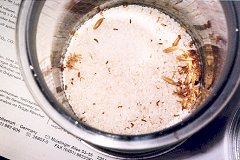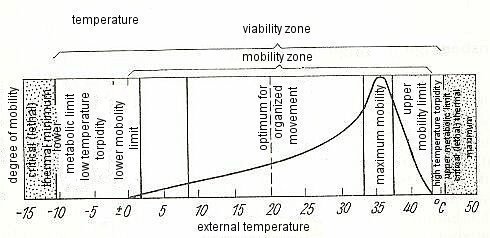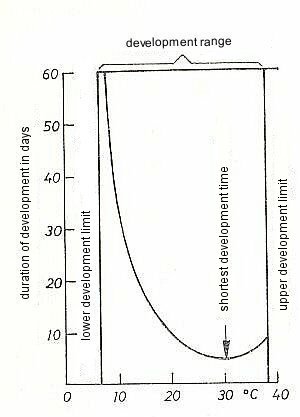Some pests are associated with particular food sources, e.g. clothes moths and fur beetles (monophagous). Most storage pests occur in almost all foodstuffs and animal feeds (polyphagous). The fact that storage pests are not generally associated with a particular product as food source may be illustrated by the copra beetle (Necrobia rufipes): copra is indeed frequently infested by the copra beetle (also known as the red-legged ham beetle), but it and its larvae also infest casings, dried fruit, peanut cake, figs, furs, hides, cheese, cocoa, coconut cake, desiccated coconut, dried egg yolk, dried meat (sausage), ham and bacon.
Copra infested with copra beetles must therefore not be stowed in the same container as the goods listed above or stored near them in a warehouse.
Cockroaches not only eat foodstuffs but also paper, textiles and leather goods.
Rats may likewise inflict considerable damage not only on foodstuffs but also, for example, on bales of silk.
Significant damage has also been caused by, among other things, the tobacco beetle (Lasioderma serricorne), which has been known to migrate from copra flakes to tea chests. Fumigation of the tea chests impaired the quality of the product by 50%, as well as being in itself a costly process.
They are also to be found in packaging material (barrels, cases, fabric wrappings).
It should also be pointed out that storage pests can go without food for extended periods. The khapra beetle (Trogoderma granarium), for instance, can manage for around a year without food (see Fig. 61).
 Figure 61: Khapra beetle |
It should therefore never be assumed that all pests are removed when a container is unpacked or a warehouse is emptied. Even if several voyages are then made carrying goods which are unsuitable as food sources for storage pests (paper, machines, porcelain etc.), fumigation should still be carried out. If a container is then once again packed with suitable goods, the pests will be very greedy after their long period of starvation and will cause a particularly large amount of damage. |
Temperature requirements
As far as temperature requirements are concerned, a distinction may be drawn between warm-blooded (homeothermic) animals and cold-blooded (poikilothermic) animals.
Warm-blooded animals, such as rats and mice, control their vital functions by maintaining a constant body temperature. Rats and mice can therefore manage easily even in refrigerated containers or cold stores.
Cold-blooded animals, which include insects and thus the majority of storage pests, are dependent to a great extent on external temperatures. Their metabolic functions, such as respiration, food intake, mobility and multiplication, are highly temperature-dependent, as is clear from the optimum curves in Figs. 62 and 63.
 |
| Figure 62: Insect mobility as a function of external temperature and limits of viability Herrmann [17] |
Figure 62, which illustrates the mobility curve and temperature limits for insect viability, provides the following information:
There is a close relationship between temperature and metabolism. As temperature increases, the rate of chemical and enzymatic reaction and thus the metabolic rate of the body increase, so improving the mobility of the animals. The mobility zone ranges from 0 - 45°C, the optimum for organized movement being 20°C and maximum mobility being present at 37°C. It is possible to conclude from this that, as the temperature in the container rises, the risk of storage pest infestation of neighboring batches of cargo is increased. Maximum mobility is quickly exceeded, however, with the curve falling steeply from 37°C to 45°C, the reason being that the enzymes suffer increasing damage at elevated temperatures due to protein denaturation, leading ultimately to death due to overheating (critical (lethal) thermal maximum 45 - 50°C). Insect infestation may therefore be combated by heating to a temperature which kills the insects (70°C).
 |
Figure 63: Duration of development of meal moths as a function of temperature Herrmann [17] |
At low temperature, metabolic processes diminish, resulting in a slowing of movement, until the lower mobility limit of 0°C is reached. Finally, low temperature torpidity is reached, all vital functions stop and death occurs as a result of the cold (critical (lethal) thermal minimum) if freezing occurs. Poikilothermic pests are therefore of no relevance in refrigerated containers.
In general, the lower mobility limit is 5 - 10°C, while some insects suffer low temperature torpidity at temperatures as high as 15°C.
The individual stages of development of storage pests, such as eggs, larvae and imagoes (fully developed insects), also proceed with regard to duration in the manner of an optimum curve, as shown in Fig. 63 for the development of meal moth eggs. This illustration reveals that at 30°C the eggs need only approximately five days to develop, while the duration of development is extended to thirty days if the temperature is reduced to 10°C.
The vital optimum temperature, at which the number of offspring is at its greatest and mortality at its lowest, i.e. when cargoes are at their greatest risk of animal pest infestation, is between 25 and 30°C.
Life span is not as closely related to temperature as is metabolic activity. Low temperatures and thus a reduced metabolic rate may even increase life span.
Complete withdrawal of food is therefore better tolerated at low temperatures (life span of granary weevils at 5 - 6°C approximately twelve months) than at higher temperatures (life span of granary weevils at 8 - 20°C approximately two to three months), meaning that a temporary lack of food is not lethal.
The comfort or preferred temperature indicates what temperatures animal pests prefer if given a choice between holds kept at different temperatures. Animal pests coming from the tropics prefer higher temperatures than those from temperate latitudes. This would suggest that the greatest damage caused by animal storage pests is to be expected in tropical zones or, in cooler climatic regions, during the warm season. However, it is important to bear in mind that animal activity may also occur in the winter months if heat and moisture evolve due to severe pest infestation.
Humidity/Moisture
In addition to temperatures, water content and relative humidity are also significant. On the basis of humidity/moisture requirements, a distinction may be drawn between two groups:
- insects to which elevated humidity values are essential to prevent drying out, e.g. cockroaches, silverfish, plaster beetles, cheese mites, grain mites and which may be killed if moisture is withdrawn.
Flour or cereals with a water content of < 12% (air equilibrium moisture content 55%) cannot any longer be infested by the grain mite.
- insects which can develop on a relatively dry substrate; cereal pests, for example, require a water content of only 14% and a relative humidity of 70 - 75%. It can be concluded from this that dry storage and low temperatures offer good protection against animal infestation.
Habitats
A characteristic feature of animal storage pests is the way they seek out nooks and crannies. This is caused by two factors:
- a degree of photophobia, causing them to withdraw into crevices and slits when exposed to light
- touch stimuli (thigmotaxis), causing them to respond by changing their location. Thigmotaxis causes insects to try to surround themselves with solid walls on all sides, so meaning that they will withdraw into nooks and crannies even in completely dark holds (e.g. cockroaches, woodlice).
They are then ready to infest newly accepted cargoes, which is why containers must be absolutely clean before acceptance of a consignment.
Habitats may also be changed as a function of pest metamorphosis. For example, imagoes (imagines) seek out new places as breeding grounds for laying eggs, while larvae seek out pupation sites. In this way, damage sometimes occurs during transport which is not caused by pests typical of the particular type of cargo but rather by "migrants" from accompanying cargoes. The risk of such damage is the greater, the longer the route and duration of transport. Some examples follow:
- In one instance, a large number of bacon beetle larvae (Dermestes lardarius) migrated from the salty, damp environment of animal hides, which they needed for development during the larval stage, into the accompanying cargo of viscose staple fiber bales, so as to undergo their metamorphosis in the dry cloth bales. Pupae and hatching beetles were found there, so turning the migrant bacon beetle into a textile pest.
- Severe damage was caused to a batch of pullovers from East Asia. A third of the pullovers displayed eating damage caused by red-legged ham beetles (Necrobia rupifes), which had hatched out of a consignment of copra and multiplied considerably in number. In their search for new breeding grounds, the beetles had got into wooden cases and thence through metal foils, cartons and finally through plastic bags into the woolen goods. As this environment did not appeal to them, they tried to chew their way back out and, in so doing, caused considerable destruction to the pullovers.
- Larvae from the yellow mealworm (Tenebrio molitor) migrated during transport from an accompanying cargo of flour and rolled oats into a consignment of pullovers, for pupation.
- The larvae of the tobacco beetle (Lasioderma serricorne) do not restrict themselves to tobacco leaves, but instead have been known also to destroy the packaging material made of hard sacking.
- Horntails may migrate from fresh lumber into textiles - the hatching insects will chew their way through any type of textiles.
From these examples, it may be concluded that, especially on long voyages, it is essential not to stow foodstuffs and semiluxury items, hides and furs together in a container with textiles of any kind.